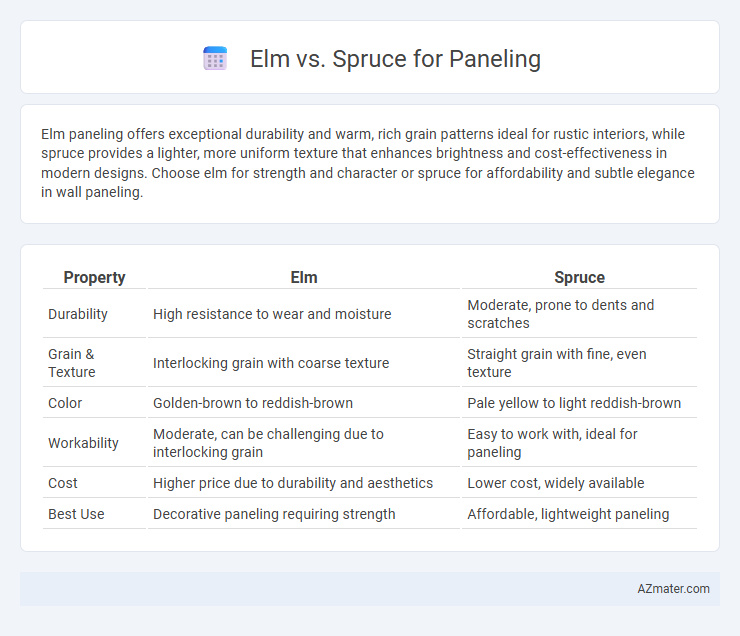Elm paneling offers exceptional durability and warm, rich grain patterns ideal for rustic interiors, while spruce provides a lighter, more uniform texture that enhances brightness and cost-effectiveness in modern designs. Choose elm for strength and character or spruce for affordability and subtle elegance in wall paneling.
Table of Comparison
| Property | Elm | Spruce |
|---|---|---|
| Durability | High resistance to wear and moisture | Moderate, prone to dents and scratches |
| Grain & Texture | Interlocking grain with coarse texture | Straight grain with fine, even texture |
| Color | Golden-brown to reddish-brown | Pale yellow to light reddish-brown |
| Workability | Moderate, can be challenging due to interlocking grain | Easy to work with, ideal for paneling |
| Cost | Higher price due to durability and aesthetics | Lower cost, widely available |
| Best Use | Decorative paneling requiring strength | Affordable, lightweight paneling |
Introduction to Elm and Spruce Paneling
Elm paneling offers a rich, warm grain with natural durability, making it ideal for traditional and rustic interiors that require both strength and aesthetic appeal. Spruce paneling features a lighter color with a fine, consistent texture, often preferred for modern or Scandinavian designs due to its smooth finish and ease of staining or painting. Both woods provide excellent insulation and are sustainably sourced options, suitable for residential and commercial wall applications.
Wood Characteristics: Elm vs Spruce
Elm wood features interlocking grain and high resistance to splitting, making it durable and suitable for intricate paneling designs, while its natural reddish-brown hue adds warmth. Spruce is lighter in weight and color with a straight, fine grain, offering ease of workability and a bright, clean aesthetic for contemporary paneling. The stronger hardness and moisture resistance of elm contrast with spruce's softness, which requires careful finishing to prevent dents and wear over time.
Aesthetic Differences: Color and Grain
Elm paneling showcases a rich, golden to medium brown color with a distinctive interlocking grain that creates dramatic, wavy patterns, adding warmth and visual interest to interiors. Spruce paneling features a pale, creamy white to light yellow hue with a straight, uniform grain, offering a clean and minimalist aesthetic ideal for modern or Scandinavian-inspired spaces. The bold, textured appearance of elm contrasts sharply with the subtle and smooth look of spruce, making each wood type suitable for different design preferences and atmospheres.
Durability and Hardness Comparison
Spruce paneling offers moderate durability with a Janka hardness rating of approximately 460, making it softer and more prone to dents and scratches compared to Elm. Elm wood, known for its interlocking grain, has a higher Janka hardness rating around 830, providing superior resistance to wear and impact. This makes Elm a more durable and hard-wearing option for paneling in high-traffic areas or where longevity is a priority.
Workability and Installation Ease
Elm wood offers excellent workability due to its interlocked grain, which provides good resistance to splitting while allowing smooth cutting and shaping, making it suitable for detailed paneling. Spruce is lightweight and soft with straight grain, enabling easy nailing and sanding, which simplifies installation and reduces labor time. Both woods provide reliable paneling options, but Elm's durability and resistance to wear often make it preferable for high-traffic areas, while Spruce excels in faster installation and cost efficiency.
Cost Analysis: Elm vs Spruce Paneling
Elm paneling typically costs more than spruce due to its denser grain and greater durability, which contributes to higher material and installation expenses. Spruce offers a more budget-friendly option with softer wood and lower market prices, making it a popular choice for large-scale or cost-sensitive projects. The overall cost analysis favors spruce for affordability, while elm presents added value through longevity and aesthetic appeal.
Environmental Impact and Sustainability
Elm paneling offers superior sustainability due to its fast growth rate and ability to thrive in diverse climates, minimizing deforestation pressures. Spruce, although lightweight and abundant, often requires extensive logging from old-growth forests that can disrupt ecosystems and reduce biodiversity. Choosing elm supports responsible forestry practices and carbon sequestration efforts, making it a more eco-friendly option for environmentally conscious construction.
Maintenance and Longevity
Elm paneling offers natural resistance to moisture and insects, making it a durable choice with moderate maintenance requirements such as periodic sealing and cleaning to preserve its appearance. Spruce paneling tends to be more affordable but requires more frequent upkeep, including regular sealing and protection from moisture to prevent warping and decay. Over time, elm's denser grain structure contributes to greater longevity and reduced risk of damage, while spruce may need more frequent repairs or replacement in high-moisture environments.
Best Applications for Each Wood Type
Elm wood is ideal for paneling in rustic or traditional interiors due to its interlocking grain and natural resistance to splitting, making it excellent for high-traffic areas and furniture backing. Spruce, with its straight grain and lighter color, is best suited for modern or minimalist paneling applications, especially in interiors requiring a smooth, paint-ready surface or increased acoustic properties. Both woods offer durability, but elm's density supports more structural paneling, while spruce enhances aesthetics and sound insulation.
Elm vs Spruce: Which is Better for Your Project?
Elm offers superior durability and natural resistance to moisture and decay, making it ideal for high-traffic or outdoor paneling projects, while spruce provides a lighter, more affordable option with a uniform grain suited for interior applications. Elm's rich texture and strength contribute to a more robust and visually striking finish, whereas spruce is easier to work with due to its softness but may require additional treatment for longevity. Choosing between elm and spruce depends on project requirements for durability, aesthetic appeal, and budget constraints.

Infographic: Elm vs Spruce for Paneling
 azmater.com
azmater.com